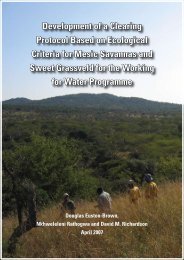Metsi Consultants - DWA Home Page
Metsi Consultants - DWA Home Page
Metsi Consultants - DWA Home Page
You also want an ePaper? Increase the reach of your titles
YUMPU automatically turns print PDFs into web optimized ePapers that Google loves.
Report No 678-F-001<br />
METSI CONSULTANTS: SUMMARY OF MAIN FINDINGS FOR PHASE 1 DEVELOPMENT<br />
SECTION 13. IFR ASSESSMENT IN SOUTHERN AFRICA<br />
The IFR assessment undertaken for the LHWP is, in many respects, the most detailed and advanced flow<br />
assessment yet undertaken in southern Africa, and indeed anywhere in Africa. Key features have been the<br />
comprehensive and integrated hydrological, biophysical and social approach, and the specific inclusion of<br />
subsistence users into the assessment. Overall, the lessons learnt during the LHWP study are of great interest<br />
and value to the rest of the world, and the expertise gained by both scientists and managers could and should be<br />
exported to the rest of Africa and further. However, as noted below, IFA is not unique to Lesotho and<br />
environmental flows are currently a subject of concern in eight southern African countries and in five other African<br />
nations.<br />
13.1. METHODS FOR ENVIRONMENTAL FLOW ASSESSMENT<br />
The methods used in the LHWP to address the use of environmental flows for river management area comprise<br />
the most advanced within four categories used in southern Africa 1 .<br />
Reconnaissance-level assessments rely on historical hydrological records for setting flow targets; the<br />
methods involve the least investment of time and effort, but there is the lowest confidence in their<br />
predictions; they do not necessarily have any ecological relevance; their best use is in large-scale<br />
regional planning of water resources.<br />
Hydraulic methods require site measurements of the river, and are used in conjunction with hydrological<br />
analysis to assess flows that occur often and are deemed to provide ‘good habitat’; links to the river<br />
ecosystem are tentative or absent, and ‘good habitat’ is largely a value judgement.<br />
Habitat-simulation methodologies link site-specific physical and hydraulic data for a range of discharges<br />
to favoured habitat of selected species and provide a more structured assessment of discharges and the<br />
related ‘good habitat’. These approaches have been used predominantly by Northern Hemisphere<br />
countries where decades of research have provided sufficient data for high-resolution descriptions of the<br />
flow requirements of selected plant and animal species. The methods focus on single species, usually<br />
fish of important recreational or economic value, and largely ignore the other parts of the ecosystem<br />
(e.g., aquatic invertebrates, water birds, riparian trees, marginal vegetation, algae), which are also flow<br />
dependent and which will influence the fish populations in some way. They focused mainly on the lowflow<br />
regime of the rivers in question.<br />
Holistic approaches address all parts of the ecosystem and all parts of the flow regime, and include the<br />
Building Block Methodology (BBM) used in South Africa, the Holistic Approach developed in Australia,<br />
and now the DRIFT (Downstream Response to Imposed Flow Transformations) approach used in the<br />
LHWP-affected rivers and described earlier in this report. A further development is the Flow Restoration<br />
Method used in Australia to address river rehabilitation. Holistic approaches are increasingly being<br />
recognized globally as the most appropriate way to do IFA as they allow a comprehensive assessment<br />
of the likely ecological and subsistence implications of a range of possible flow manipulations, thus<br />
placing before the decision-maker new information to supplement traditional engineering and economic<br />
information upon which water-resource decisions have been made in the past.<br />
1 Details and references are given in Paxton, B., C.B. Brown and J.M. King. 2002. A review of activities linked to<br />
environmental flows in Africa. Unpubl. ms.<br />
73

















